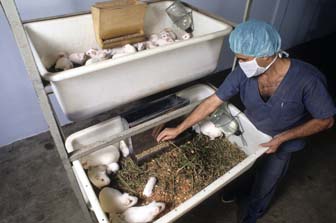Summary
Please enable javascript to play this video.
| Quick Facts: Veterinary Technologists and Technicians | |
|---|---|
|
$45,980 per year
$22.11 per hour |
|
| Associate's degree | |
| None | |
| None | |
| 134,200 | |
| 9% (Much faster than average) | |
| 12,200 | |
What Veterinary Technologists and Technicians Do
Veterinary technologists and technicians do medical tests that help diagnose animals’ injuries and illnesses.
Work Environment
Veterinary technologists and technicians work in private clinics, laboratories, and animal hospitals. Their jobs may be physically or emotionally demanding. Many work evenings, weekends, or holidays.
How to Become a Veterinary Technologist or Technician
Veterinary technologists and technicians must complete a postsecondary program in veterinary technology. Technologists usually need a 4-year bachelor’s degree, and technicians need a 2-year associate’s degree. Typically, both technologists and technicians must take a credentialing exam and become registered, licensed, or certified, depending on the requirements of the state in which they work.
Pay
The median annual wage for veterinary technologists and technicians was $45,980 in May 2024.
Job Outlook
Employment of veterinary technologists and technicians is projected to grow 9 percent from 2024 to 2034, much faster than the average for all occupations.
About 14,300 openings for veterinary technologists and technicians are projected each year, on average, over the decade. Many of those openings are expected to result from the need to replace workers who transfer to different occupations or exit the labor force, such as to retire.
State & Area Data
Explore resources for employment and wages by state and area for veterinary technologists and technicians.
Similar Occupations
Compare the job duties, education, job growth, and pay of veterinary technologists and technicians with similar occupations.
More Information, Including Links to O*NET
Learn more about veterinary technologists and technicians by visiting additional resources, including O*NET, a source on key characteristics of workers and occupations.
 United States Department of Labor
United States Department of Labor









